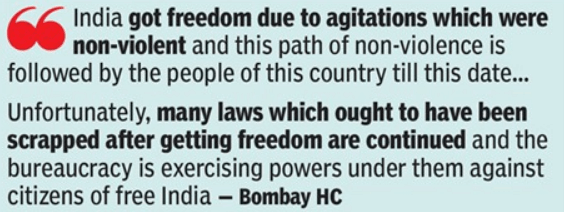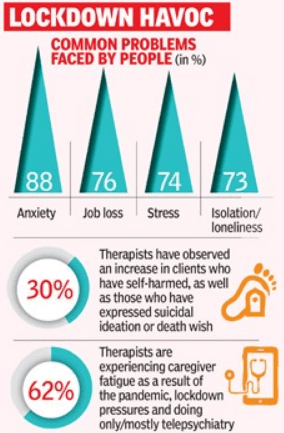The Hindu Editorial Analysis- 10th October, 2020 | Additional Study Material for UPSC PDF Download

1. THE RIGHT BALANCE: ON SHAHEEN BAGH AND THE RIGHT TO PROTEST-
GS 2- Important aspects of governance, transparency and accountability
Context
(i) Long after Shaheen Bagh became a potent(powerful) symbol of democratic resistance against a discriminatory law, the Supreme Court has ventured to hold that any such indefinite blockade of a public pathway is unacceptable.
(ii) And that the administration ought to take action to remove “encroachments(intrusion) and obstructions” placed during such protests.

Balancing
(i) The Court’s assertion was made even while “appreciating the existence of the right to peaceful protest against a legislation”.
(ii) On the face of it, the Court’s view arises from a straightforward balancing of two contrasting rights — the right to protest and the right to free movement.
(iii) However, a moot(arguable) question is whether the manner and content of a protest should always conform(satisfy) to forms deemed acceptable by the law.
(iv) Protests, by their very nature, are not always rooted in legality, but rather derive legitimacy from the rightness of the underlying cause and the extent of public support.
(v) In many cases, they are against laws and regulations perceived as unjust.
(vi) A flash strike, a spontaneous road block, a call for a complete shutdown, or a campaign to fill up jails by defying prohibitory orders — each of these is not, in a strict sense, legal; but, at the same time, it is an inevitable part of the culture of protest in a democracy.
(vii) In this case, the Court rightly notes that the administration neither negotiated with the protesters in Shaheen Bagh nor tried to clear the scene.
Judicial Certitude
(i) Any finding that a peaceful protest had continued too long, or in a place deemed inconvenient to others, should not encourage the administration to seek early curbs on the freedom of assembly.
(ii) After the pandemic led to the end of the protests, there was little left for adjudication, and the Court’s remarks might come across as a gratuitous(unjustified) offering to administrators looking to de-legitimise protests.
(iii) Following the earlier judgment that any ‘bandh’ is illegal, courts routinely stayed sector-wide strikes.
(iv) Another aspect of the present ruling is the assertion that protests should be confined to “designated places”.
(v) Such judicial certitude(certainity) may end up undermining the larger democratic need for public expression of dissent in a manner and place that would be most effective.
(vi) While notified demonstrations are subject to regulations regarding time and space, it may not be possible to extend the same to spontaneous, organic and leaderless protests driven by a cause.
(vii) The ruling should not form the basis for suppression of such protests by the force of the state.
(viii) Both principles — the need for balance between the right to protest and the right to free movement, and the rule that protests should take place at designated spots — are salutary(beneficial) from an administrative point of view.
(ix) But these cannot become unquestionable axioms(principle) to the point of rendering any and all protests that cause inconvenience to others the target of the strong arm of the state.
Conclusion
Sudden, organic protests should not automatically invite the state’s strong arm.
2. SAVING LIVES UNDER THE LONG SHADOW OF THE PANDEMIC-
GS 2- Issues relating to development and management of Social Sector/Services relating to Health
Context
(i) The COVID-19 pandemic has ‘impacted populations around the world in multiple ways.
(ii) The fear of being infected and anxiety about an uncertain present and future have impacted mental health severely.
(iii) Lockdowns have led to isolation, in turn heightening anxiety and causing depression in societies, particularly in vulnerable communities’.

Mental Health Disorders
(i) While the novel coronavirus pandemic is ‘unprecedented in its scope and scale, previous studies suggest an elevated(heightened) risk of suicide during such times’.
(ii) There is some evidence that ‘deaths by suicide increased in the US during the 1918-19 influenza pandemic, and among older people in Hong Kong during the 2003 Severe Acute Respiratory Syndrome (SARS) epidemic’.
(iii) However, it has been noted that a rise in suicides in the wake of the pandemic is not inevitable(unavoidable).
(iv) In fact, preliminary information from New Zealand, Japan and the United Kingdom suggest lower suicidal behaviour at least in the early phase of the pandemic.
(v) Before the pandemic, India’s progress as one of the fastest growing economies led to large paradigm shifts in the daily lives of its citizens.
(vi) Major lifestyle shifts led to the rise of many lifestyle disorders in the last decade.
(vii) Mental health disorders are one of the disorders of most concern, which have been swept under the carpet of stigma(shame) and discrimination.
(viii) Many suicides are related to psychological disorders and distress.
New Normal, Consequences
(i) The pandemic’s massive toll on human well-being — in a physical and mental sense — has completely changed the way people live.
(ii) Necessary precautions such as social distancing, limited interactions and mask usage have become the new normal, with a huge social, physical, economic and mental consequences.
(iii) Unfortunately, India has the dubious distinction of reporting the first COVID-19-related suicide in the world, on February 12, 2020.
(iv) While the pandemic has affected the entire country, case incidence rates are the worst in States such as Maharashtra, Andhra Pradesh, Tamil Nadu, Karnataka and Uttar Pradesh.
(v) A worrying overlap reveals itself as some of these States are also major contributors to suicidal deaths per year — Maharashtra (18,916), followed by Tamil Nadu (13,493), West Bengal (12,665), Madhya Pradesh (12,457) and Karnataka (11,288).
(vi) Dire(severe) socio-economic conditions arising from the pandemic — mass migration, unemployment and economic distress — make at-risk groups even more vulnerable during these times.
Rising Stress
(i) While progress on a COVID-19 vaccine is promising, uncertainty as a result of the pandemic is here to stay for the foreseeable future.
(ii) The fear of getting infected, coupled with a lack of knowledge and the economic fallout has created a new level of stress not seen by many before.
(iii) This is compounded(made difficult) by isolation from the community, causing high levels of mental duress(stress) and ultimately, COVID-19-related suicides for many.
(iv) This situation is the worse among vulnerable populations who are susceptible to greater risks of infections, such as-
(a) health-care workers,
(b) infected people,
(c) the elderly, migrant workers,
(d) those from resource-poor backgrounds,
(e) women facing domestic violence,
(f) individuals with compromised(weak) immunity,
(g) and those suffering from physical or psychological problems.
(v) A case series of newspaper reports of suicide in India during the early lockdown phase found that suicide was associated with the fear of infection, social isolation and pandemic-related economic concerns.
(vi) The findings reveal that one in four of these deaths occurred among hospitalised patients, demonstrating the need for extra care and vigilance during institutional treatment for either COVID-19 or any other illness.
(vii) The sudden closure of alcohol/liquor outlets resulted in an increase in alcohol-related suicides.
(viii) As we continue to fight the novel coronavirus, there is a growing need to make mental health and suicide prevention a priority.
(ix) At an individual level, any early signs of poor mental health such as a sudden change in behaviour, substance use, anxiety, disturbed sleep and difficulty in communication should not be ignored.
(x) While the feeling of uncertainty during this pandemic is normal, being informed and limiting ourselves to authentic sources of information and reducing exposure to distressing news is a good mechanism to help a person cope with the situation.
Media’s Role
(i) Suicide prevention requires a mix of a top-down and a bottom-up approach, ensuring that all interventions are rooted in empathy(understanding others).
(ii) India has created a task force to develop a national suicide prevention strategy.
(iii) The plan incorporates the three universal strategies,
(a) including a ban or reduction in access to highly hazardous pesticides,
(b) reduction in consumption and availability of alcohol,
(c) and a non-sensationalised and responsible portrayal of suicide by the media.
(iv) The media would need to follow Press Council of India’s guidelines on reportage of suicide and also create awareness about suicide prevention.
Seeking Support Is Key
(i) There is an urgent need for destigmatizing(removing shame) suicide as a phenomenon and ensure there is an increase in the number of functional and accessible helplines and training of gatekeepers.
(ii) Most importantly, a system intervention can focus on identifying, supporting and referring suicidal individuals at all levels of the health-care system.
(iii) It is essential that if suicide has been attempted the individual has the required intervention and regular contact support.
(iv) A majority of individuals who are suicidal do not really want to die but find living difficult. Support at the right moment can change this decision.
(v) Understanding, compassion and support, at both an individual and the systemic levels, can save a life.
Conclusion
On World Mental Health Day (October 10), there is the most important message for the ones who may be having suicidal thoughts: You are not alone and must reach out for support, as help is available.
|
21 videos|562 docs|160 tests
|
FAQs on The Hindu Editorial Analysis- 10th October, 2020 - Additional Study Material for UPSC
| 1. What is the significance of The Hindu Editorial Analysis for UPSC exam preparation? |  |
| 2. How can The Hindu Editorial Analysis help in improving language skills for the UPSC exam? |  |
| 3. How can one effectively utilize The Hindu Editorial Analysis for current affairs preparation in UPSC? |  |
| 4. Can The Hindu Editorial Analysis be used as a reference for essay writing in the UPSC exam? |  |
| 5. How can one stay consistent with The Hindu Editorial Analysis for UPSC exam preparation? |  |





















